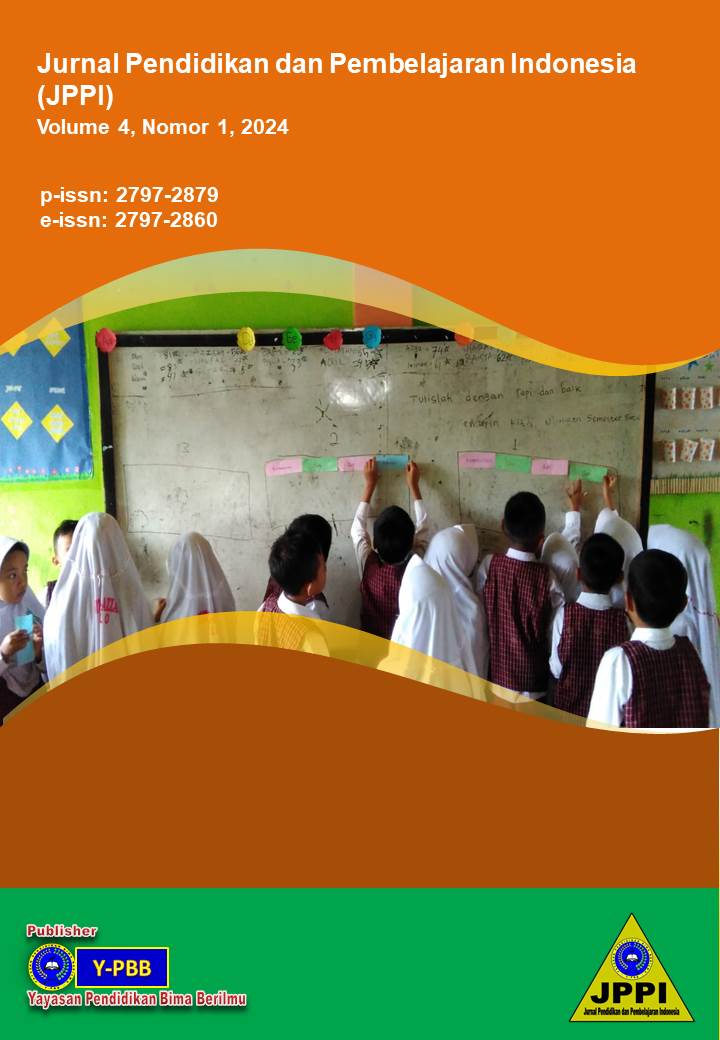Analysis of The Implementation program Numeracy Literacy for Teacher Working Groups in Building a Literate Culture
DOI:
https://doi.org/10.53299/jppi.v4i1.448Keywords:
Literacy, Numeracy, Literate CultureAbstract
This study aims to describe the analysis of the implementation programe numeracy literacy in teachers' working groups to build a culture of literacy in primary schools. This research used a qualitative method with a descriptive approach. The research subjects were six teachers who had attended literacy and numeracy training at MIM 16 Payaman and MIM 05 Palirangan. Data collection techniques were conducted using interviews, observation, and documentation. The results showed that the literacy and numeracy program in the teachers' working group can apply tactical implementation strategies to literacy and numeracy skills in the physical, socio-emotional, and academic domains so this is the starting point for creating a culture of literacy in schools. Teachers can also carry out mapping, advocacy, mentoring, monitoring, and evaluation of literacy and numeracy activities carried out at school. Teachers can carry out various activities to implement a culture of numeracy literacy at school and home, such as creating a reading corner in the classroom. Teachers can integrate literacy and numeracy skills through tasks carried out by students according to what is obtained from the teacher's working group.
References
Burmeist Ashri, D. N., & Pujiastuti, H. (2021). Literasi Numerasi Pada Pembelajaran Tematik Terpadu Di Kelas Rendah Sekolah Dasar. Jurnal Karya Pendidikan Matematika, 8(2), 1–7.
Bao, X., Qu, H., R, Z., & Hogan, T. (2020). Literacy loss in kindergarten children during COVID-19 school closures. SocArXiv, 1–16. https://osf.io/preprints/socarxiv/gh4rv/
Casmat, M., & Andayani. (2022). Teacher’s Profile as An Agent of Change in Preparing School And People at the New Normal Era. Pedagogia Jurnal Ilmu Pendidikan, 20(01), 15–20.
Dantes, N., & Handayani, N. N. L. (2021). Peningkatan Literasi Sekolah Dan Literasi Numerasi Melalui Model Blanded Learning Pada Siswa Kelas V SD Kota Singaraja. WIDYALAYA: Jurnal Ilmu Pendidikan, 1(3), 269–283. http://jurnal.ekadanta.org/index.php/Widyalaya/article/view/121
Duckworth, V., & Brzeski, A. (2015). Literacy, Learning and Identity: Challenging the Neo-Liberal Agenda Through Literacies, Everyday Practices and Empowerment. Research in Post-Compulsory Education, 20(1), 1–16. https://doi.org/10.1080/13596748.2015.993861
Ekowati, D. W., Astuti, Y. P., Utami, I. W. P., Mukhlishina, I., & Suwandayani, B. I. (2019). Literasi Numerasi di SD Muhammadiyah. ELSE (Elementary School Education Journal), 3(1), 93. https://doi.org/10.30651/else.v3i1.2541
Fasya, M., & Amalia, F. (2015). Mimpi menjadi Bangsa Literat. Akrab, VI(2), 33–35.
Goos, M., Geiger, V., Dole, S., Forgasz, H., & Bennison, A. (2020). Numeracy Across the Curriculum. In Numeracy Across the Curriculum (Issue June 2014). https://doi.org/10.4324/9781003116585
Humairah, H., Zativalen, O., & Nurhasanah, N. (2022). Pengaruh Model Pembelajaran Kooperatif Tipe Picture and Picture Terhadap Hasil Belajar Siswa Matematika MI Muhammadiyah I Payaman. Jurnal Jendela Pendidikan, 2(01), 82-86.
Kementrian Pendidikan, Kebudayaan,, D. (2019). Desain Induk Gerakan Literasi Sekolah (Direktorat Jenderal Pendidikan Dasar dan Menengah Kementrian Pendidikan dan Kebudayaan). https://gln.kemdikbud.go.id/glnsite/wp-content/uploads/2019/07/Desain-Induk-Gerakan-Literasi-Sekolah-2019.pdf
Kementrian Pendidikan, Kebudayaan, R. dan T. (2021). Modul Literasi Numerasi Di Sekolah Dasar. Modul Literasi Numerasi Di Sekolah Dasar, 1, 22. http://ditpsd.kemdikbud.go.id/upload/filemanager/2021/06/2 Modul Literasi Numerasi.pdf
Kementerian Pendidikan dan Kebudayaan. 2016. Gerakan Literasi Nasional Materi Pendukung Literasi Numerasi. Jakarta: Tim Gerakan Literasi Nasional.
Khairi, A., Sasongko, R. N., & Kristiawan, M. (2021). Literacy of Lower Classes Students Primary School in the 2013 Curriculum during the Pandemic COVID-19. Linguistic, English Education and Art (LEEA), 4(2), 375–386. https://journal.ipm2kpe.or.id/index.php/LEEA/article/view/2237
Khakima, L. N., Zahra, S. F. A., Marlina, L., & Abdullah, Z. (2021). Penerapan Literasi Numerasi dalam Pembelajaran Siswa MI/SD. Prosiding Seminar Nasional PGMI, 775–791. http://proceeding.iainpekalongan.ac.id/index.php/semai-775-
Mallows, D., & Litster, J. (2016). Literacy as supply and demand. Zeitschrift Für Weiterbildungsforschung, 39(2), 171–182. https://doi.org/10.1007/s40955-016-0061-1
Mulyasa, E. (2009). Menjadi Guru Profesional. Bandung: PT Remaja Rosdakarya
Patriana, W. D., Sutama, S., & Wulandari, M. D. (2021). Pembudayaan Literasi Numerasi untuk Asesmen Kompetensi Minimum dalam Kegiatan Kurikuler pada Sekolah Dasar Muhammadiyah. Jurnal Basicedu, 5(5), 3413–3430.
Perdana, R., & Suswandari, M. (2021). Literasi Numerasi Dalam Pembelajaran Tematik Siswa Kelas Atas Sekolah Dasar. Absis: Mathematics Education Journal, 3(1), 9. https://doi.org/10.32585/absis.v3i1.1385
Sugiyono. 2015. Metode Penelitian Kuantitatif, Kualitatif, dan R&D. Bandung : ALFABETA.
Tavdgiridze, L. (2016). Literacy Competence Formation of the Modern School. Journal of Education and Practice,7(26), 107–110. https://files.eric.ed.gov/fulltext/EJ1115864.pdfer, M., Schmidt-Jacob, S., & Eilks, I. (2013). German chemistry teachers’ understanding of sustainability and education for sustainable development - An interview case study. Chemistry Education Research and Practice, 14(2), 169–176. https://doi.org/10.1039/c2rp20137b
Shidiq, A. S., Permanasari, A., Hernani, H., & Hendayana, S. (2022). Contemporary Hybrid Laboratory Pedagogy : Construction of a Simple Spectrophotometer with STEM Project-Based Learning to Introduce Systems Thinking Skills. Asia Pacific Journal of Educators and Education, 37(2), 107–146.
Yamtinah, S., Susanti VH, E., Saputro, S., Ariani, S. R. D., Shidiq, A. S., Sari, D. R., & Ilyasa, D. G. (2023). Augmented reality learning media based on tetrahedral chemical representation: How effective in learning process? Eurasia Journal of Mathematics, Science and Technology Education, 19(8), em2313. https://doi.org/10.29333/ejmste/13436
Downloads
Published
Issue
Section
License
Copyright (c) 2024 Jurnal Pendidikan dan Pembelajaran Indonesia (JPPI)

This work is licensed under a Creative Commons Attribution 4.0 International License.














